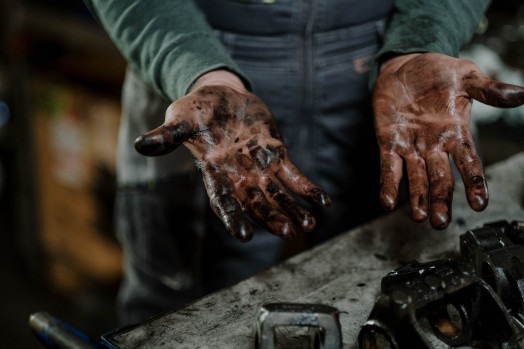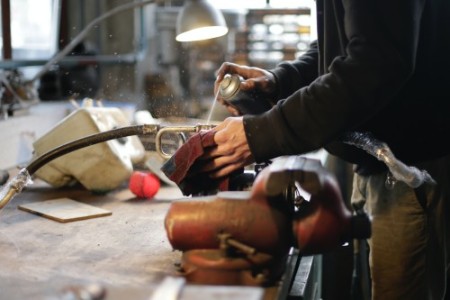The engine is a motorcycle’s beating heart, and to perform at its peak in the intricate motorbike ballet, it requires a well-maintained oil system. On the other hand, riders occasionally notice a concerning sight: a clear oil leak emanating from the engine’s bottom. It’s imperative to act fast since ignored leaks might cause major engine damage. This article examines the causes of motorcycle oil leaks, focusing especially on leaks from the engine’s lower components, and provides practical solutions. By being aware of the common offenders and doing preventative maintenance, motorbike owners can ensure that their cars are reliable and ready for use.
Common Causes of Motorcycle Oil Leaks:
There are several reasons why motorcycle oil leaks happen, and it’s important to fix them right away to avoid harm to the engine and maintain peak performance. The following are some typical reasons why motorcycle oil spills from the engine’s bottom:
Worn or Damaged Gaskets:
- When it comes to sealing the seams between engine components, gaskets are essential.
- Gaskets may deteriorate, break, or start to leak with time.
- The crankcase, cylinder head, and valve cover gaskets are common gasket sites that are prone to leakage.

Loose or Improperly Sealed Drain Plug:
- Leaks can occur from a loose or incorrectly sealed drain plug, which is a necessity for oil changes.
- Undertightening can lead to the plug vibrating loose, while overtightening might harm the threads.
Cracked or Damaged Oil Pan:
- Engine oil is stored in a reservoir called the oil pan, which is susceptible to corrosion and impact damage.
- Major oil leaks may result from holes or cracks in the oil pan.
Overfilled Oil Level:
- If the engine is overfilled with oil, this might result in high pressure and leaks.
- To prevent overfilling, check and keep the oil level within the range suggested by the manufacturer.
Faulty Oil Filter Seal:
- There is a seal on the oil filter to stop leakage.
- Oil seepage may be caused by an improperly placed or broken oil filter.
Loose or Damaged Oil Cooler Lines:
- There is a chance that the oil cooler lines on motorcycles will break or become loose.
- Examine the oil cooler lines for wear indicators and tight connections.
Crankshaft Seal Issues:
- Oil leakage from the crankshaft region is stopped by the crankshaft seal.
- Oil leaks may result from worn or faulty seals.
Overtightened or Undertightened Bolts:
- Engine components are fastened using bolts and nuts that must be tightened in accordance with manufacturer guidelines.
- Undertightening can lead to leaks, while overtightening can cause problems with gasket compression.
Loose or Improperly Sealed Drain Plug:
Motorcycle oil leaks are frequently caused by a loose or incorrectly sealed drain plug, which must be fixed in order to preserve engine performance and avoid further damage. Here’s a summary of the problem and some solutions:
Symptoms of a Loose or Improperly Sealed Drain Plug:
Visible Oil Leakage:
- There can be an obvious leak of oil from the vicinity of the drain cap.
- Oil puddles or streaks on the ground underneath the motorbike might be signs of a leak.
Oil Stains or Residue:
- The motorcycle’s underside has accumulated oil streaks or residue, particularly in the vicinity of the oil pan and drain plug.
Low Oil Levels:
- A gradual leak may be discovered by routinely monitoring the oil level and seeing a steady decline that doesn’t seem to be related to anything.
Causes:
Incorrect Torque:
- The torque recommended by the manufacturer should be used to tighten the drain plug.
- Undertightening can cause the plug to gradually loosen, while overtightening might harm the threads.
Worn or Damaged Washer:
- A suitable seal is usually created by the drain stopper using a crush washer; leaks may occur if the washer is worn out or broken.
Solutions:
Proper Torque:
- To tighten the drain plug to the tension recommended by the manufacturer, use a torque wrench.
- The suggested torque value may be found in the motorcycle’s service manual.
Replace Crush Washer:
- Examine the crush washer for any signs of deterioration or wear.
- To guarantee a good seal, replace the crush washer with a new one after every oil change.
Check for Thread Damage:
- Look for any indications of damage on the threads of the oil pan and the drain cap.
- If there is damage to the threads, think about replacing or repairing the affected part.
Cracked or Damaged Oil Pan:
If left unattended, a cracked or broken oil pan can cause large oil leaks and possibly even damage to an engine. An outline of this issue and potential solutions is provided below:
Symptoms of a Cracked or Damaged Oil Pan:
Visible Oil Leaks:
- There might be an obvious oil leak coming from the engine’s underside.
- Oil puddles or streaks on the surface underneath the motorbike.

Low Oil Levels:
- Low oil levels that don’t go away even after refilling may be a sign of a serious leak.
Engine Overheating:
- Engine temperatures might rise and lubrication quality can be compromised by low oil levels.
Unusual Engine Noises:
- Unusual engine noises like tapping or banging may be the consequence of inadequate lubrication brought on by oil leaks.
Causes:
Impact Damage:
- An impact with a hard surface, such a curb or stone, might harm the oil pan.
Corrosion:
- Road debris and environmental exposure over time can cause corrosion, which weakens the oil pan.
Manufacturing Defect:
- Rarely, a manufacturing flaw might lead to an oil pan that is defective or weak.
Solutions:
Replacement of the Oil Pan:
- Replacing the oil pan is frequently the best course of action if it is cracked or broken.
- To find the right replacement component, consult the service manual or a qualified mechanic for your motorbike.
Repairing Small Cracks:
- Small fractures could occasionally be fixed using specialised epoxy or welding methods.
- The efficacy of this method, which is more popular for aluminium oil pans, relies on the extent and location of the damage.
Use Quality Replacement Parts:
- Use premium, manufacturer-recommended replacement parts while changing the oil pan to guarantee a correct fit and dependable operation.
Overfilled Oil Level:
A motorcycle’s overfilled oil pan can cause a number of problems, including possible engine damage. In order to guarantee adequate lubrication and avoid negative consequences, it’s critical to maintain the right oil level. An overview of the signs, reasons, and remedies for an overfilled oil level is provided below:
Symptoms of Overfilled Oil Level:
Excessive Oil Consumption:
- An engine that is overfilled may use oil more quickly than normal.
- Poor engine performance and clogged spark plugs might result from increased oil consumption.
Leaking Oil Seals:
- Overfilling can cause the engine to overpressurize, which can cause oil seal leakage.
- Crankshaft seals are one of the common places where leaks occur.
Increased Engine Temperature:
- Engine temperatures might rise as a result of increased friction and heat from overfilled oil.
- Overheating can weaken engine parts and lower overall efficiency.
Smoke from Exhaust:
- If you overfill and burn extra oil, smoke may come out of the exhaust.
- There may also be a stench like burning oil.
Causes of Overfilled Oil Level:
Incorrect Oil Change Procedure:
- One of the most prevalent causes of overfilled levels is adding too much oil during an oil change.
- Overfilling may result from improperly emptying the old oil or from misinterpreting oil capacity specifications.
Multiple Oil Changes Without Checking Levels:
- Overfilling can occur if you perform several oil changes without periodically monitoring the oil level.

Solutions:
Drain Excess Oil:
- Draining the extra oil to get the level within the advised range is the easiest way to solve the problem.
- Utilise an oil drain pan and dispose of wasted oil according to the correct procedures.
Replace Oil Filter:
- Even after the pan has been emptied, the oil filter may still hold extra oil if it was overfilled.
- To guarantee that the extra oil is eliminated throughout the rectification procedure, replace the oil filter.
Check and Correct Oil Level:
- Once the extra oil has been drained, precisely measure and correct the oil level to the manufacturer’s recommendations.
- To find out the proper oil capacity, see the motorcycle’s service handbook.
- To prevent overfilling in the future, make it a practice to check the oil level frequently, especially following oil changes.
Prevention and Maintenance Tips
Regular maintenance procedures and preventative steps are required to ensure maximum engine efficiency and prevent motorcycle oil leaks. The following preventative and maintenance advice will assist motorbike owners maintain the best possible condition for their engines:
1. Regular Inspection Routine:
Visual Checks:
- Look for any indications of damage or oil leaks on the underside of the engine, particularly the oil pan, drain plug, and surrounding regions.
- Keep an eye out for any moist areas, residue, or oil stains that can point to a problem.
Gasket Inspection:
- Inspect gaskets regularly for wear, damage, or leaks. This includes the crankcase, cylinder head, and valve cover gaskets.
Oil Cooler Lines:
- If the oil coolers on your motorbike are installed, check the lines for wear or corrosion and tight connections.
2. Quality Oil and Filter Selection:
Use High-Quality Oil:
- Select premium oil designed specifically for motorcycles that satisfies the requirements of the manufacturer.
- In accordance with the motorcycle’s service handbook, observe the suggested oil change intervals.
Select the Right Oil Filter:
- Use a reliable oil filter that fits your motorcycle model.
- Make sure everything is installed correctly and sealed tightly to stop leaks.
3. Proper Torque Specifications:
Follow Manufacturer Guidelines:
- To ensure that vital parts, including the oil pan drain plug and other engine bolts, are tightened to the tension recommended by the manufacturer, use a torque wrench.
Avoid Overtightening/Undertightening:
- Under tightening can result in loose components, while overtightening can harm threads and gaskets.
- To keep engine parts intact, stick to recommended torque settings.
4. Regular Oil Level Checks:
Monitor Oil Levels:
- Regularly check the motorcycle’s oil level, particularly before lengthy journeys.
- To avoid overfilling, keep the oil level within the range suggested by the manufacturer.
Correct Overfilled Oil Promptly:
- To avoid any damage, immediately drain any extra oil and replace the oil filter if it is overfilled.
5. Preventive Measures:
Install a Skid Plate:
- To shield the oil pan from collisions and damage during off-road or difficult riding conditions, think about fitting a skid plate.
Avoid Overheating:
- Make sure the cooling system is operating properly to avoid excessive engine heat, which can lead to leaks and breakdowns in the oil.
Frequently asked questions:
What’s causing the oil leak at the bottom of my motorbike?
Your motorcycle’s oil leak at the bottom might be the result of problems like deteriorated gaskets, a loose drain plug, a fractured oil pan or too full oil levels.
Are oil leaks repairable?
Absolutely, by locating and addressing the underlying issue—such as deteriorated gaskets or seals—oil leaks are typically repairable.
What may be causing the engine’s bottom to leak oil?
Worn gaskets, loose drain plugs, fractured oil pans, and overfilled oil levels are some of the possible causes of oil leaks from the bottom of the engine.
How can I stop oil from seeping out of my motorcycle engine?
Replace worn-out gaskets, tighten parts to the necessary torque, tighten loose drain plugs and keep the oil levels in your motorbike engine at the right levels to stop oil seepage.
Conclusion:
In conclusion, an oil system must be maintained for a motorcycle to run efficiently. Regular inspections, proper torque application, and the use of premium filters and oil may all help prevent oil leaks. Timely problem solutions and identification provide a comfortable ride and increase the motorcycle’s longevity. Preventive measures and following recommended service intervals assist maintain a bike’s quality, lower the likelihood of oil leaks, and increase riding reliability.

